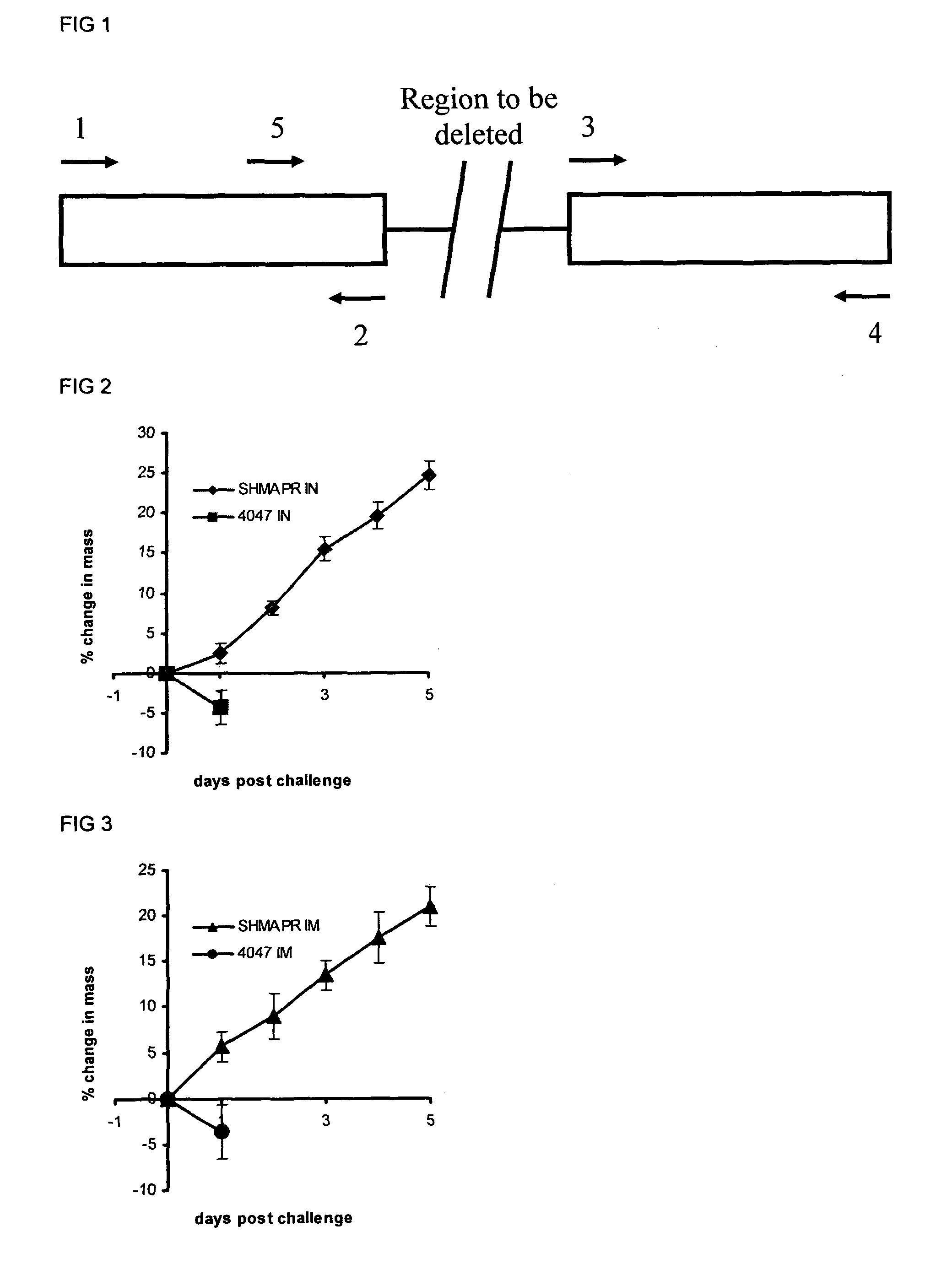Vaccines
a streptococcal pathogen and vaccine technology, applied in the field of vaccines, can solve the problems of ineffective antibiotic treatment, slow progress in the development of effective strangles vaccines, undesirable side effects, etc., and achieve the effects of reducing the possibility of strain reversion, reducing the likelihood of environmental persistence, and increasing the sensitivity of the vaccine strain to ultraviolet ligh
- Summary
- Abstract
- Description
- Claims
- Application Information
AI Technical Summary
Benefits of technology
Problems solved by technology
Method used
Image
Examples
example 1
Selection of a Mutant Strain
[0120]An example vaccine was derived from a field isolate of Streptococcus equi responsible for causing strangles in a New Forest pony in Hampshire in 1990 and is the subject of the Streptococcus equi genome-sequencing project (http: / / www.sanger.ac.uk / Projects / S_equi / ). The field strain was designated strain 4047. This strain was grown overnight, aerobically at 37° C., on blood agar and then inoculated in Todd Hewitt medium and subjected to well-described DNA mutation techniques (Maguin et al., 1992) to achieve the desired vaccine characteristics.
[0121]Briefly, the partial deletion of each target gene was performed as follows:
[0122]Upstream and downstream pieces of DNA homologous to the target gene were cloned into the pGhost9 plasmid via EcoRI and SalI restriction sites to create a copy of the target gene lacking the desired internal portion of the coding sequence. Details of the primers used to generate the required plasmids, the section of the genes to...
example 2
Preparation of Vaccine
[0132]Streptococcus equi strain SHMAPR and the wild type parent 4047 strain were grown overnight, aerobically at 37 degree. C., on blood agar and then inoculated in Todd Hewitt medium containing 10% foetal calf serum. For the vaccination / challenge studies, the strains were cultured for 6 hours at 37 degree. C. in 100 ml of Todd Hewitt medium containing 10% foetal calf serum to an OD600nm of 0.3. At this density the viable number of S. equi is 2×108 cfu / ml.
example 3
Intranasal Safety Test of the Vaccine Strain SHMAPR in Mice
[0133]In this example, the rate of attenuation of the S. equi SHMAPR as compared to the wild-type strain 4047 has been tested in mice. 4×108 CFU of the mutant strain as well as the parent 4047 wild-type strain were applied intranasally to mice and mortality was recorded.
Animals
[0134]BALB / c mice, 4 weeks of age, obtained from Charles River Ltd, were used for the experiment.
Vaccination / Challenge Cultures
[0135]Streptococcus equi strain SHMAPR and the wild type parent 4047 strain were grown overnight, aerobically at 37° C., on blood agar and then inoculated in Todd Hewitt medium containing 10% foetal calf serum. The strains were then cultured for 6 hours at 37° C. in 20 ml of Todd Hewitt medium containing 10% foetal calf serum to an OD600nm of 0.3. At this density the viable number of S. equi is 2×108 cfu / ml.
Treatment
[0136]At 4 weeks of age, 1 group of 30 mice sedated with 100 mg / kg ketaset, was challenged intranasally (20 μl) w...
PUM
| Property | Measurement | Unit |
|---|---|---|
| temperature | aaaaa | aaaaa |
| temperature | aaaaa | aaaaa |
| antibiotic resistance | aaaaa | aaaaa |
Abstract
Description
Claims
Application Information
 Login to View More
Login to View More - R&D
- Intellectual Property
- Life Sciences
- Materials
- Tech Scout
- Unparalleled Data Quality
- Higher Quality Content
- 60% Fewer Hallucinations
Browse by: Latest US Patents, China's latest patents, Technical Efficacy Thesaurus, Application Domain, Technology Topic, Popular Technical Reports.
© 2025 PatSnap. All rights reserved.Legal|Privacy policy|Modern Slavery Act Transparency Statement|Sitemap|About US| Contact US: help@patsnap.com



